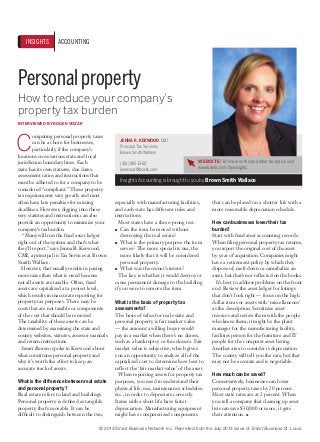How to Reduce Your Company’s Property Tax Burden
•
0 likes•275 views
How can companies reduce their tax burden? Jenna Kerwood, principal, tax services practice at Brown Smith Wallace, discusses the benefits of a personal property tax review and why it’s worth the effort to keep accurate asset accounting records.
Report
Share
Report
Share
Download to read offline

Recommended
Recommended
More Related Content
More from Brown Smith Wallace
More from Brown Smith Wallace (20)
Employer and Employee Costs for Various Health Plan Types

Employer and Employee Costs for Various Health Plan Types
Value Stream Mapping: How to Identify and Reduce Waste

Value Stream Mapping: How to Identify and Reduce Waste
Recently uploaded
Recently uploaded (20)
Unlock Your TikTok Potential: Free TikTok Likes with InstBlast

Unlock Your TikTok Potential: Free TikTok Likes with InstBlast
What is social media.pdf Social media refers to digital platforms and applica...

What is social media.pdf Social media refers to digital platforms and applica...
Sedex Members Ethical Trade Audit (SMETA) Measurement Criteria

Sedex Members Ethical Trade Audit (SMETA) Measurement Criteria
Aptar Closures segment - Corporate Overview-India.pdf

Aptar Closures segment - Corporate Overview-India.pdf
Engagement Rings vs Promise Rings | Detailed Guide

Engagement Rings vs Promise Rings | Detailed Guide
HAL Financial Performance Analysis and Future Prospects

HAL Financial Performance Analysis and Future Prospects
Blinkit: Revolutionizing the On-Demand Grocery Delivery Service.pptx

Blinkit: Revolutionizing the On-Demand Grocery Delivery Service.pptx
8 Questions B2B Commercial Teams Can Ask To Help Product Discovery

8 Questions B2B Commercial Teams Can Ask To Help Product Discovery
Series A Fundraising Guide (Investing Individuals Improving Our World) by Accion

Series A Fundraising Guide (Investing Individuals Improving Our World) by Accion
How to Reduce Your Company’s Property Tax Burden
- 1. INSIGHTS ACCOUNTING Personal property How to reduce your company’s property tax burden INTERVIEWED BY ROGER VOZAR C omputing personal property taxes can be a chore for businesses, particularly if the company’s locations cross various state and local jurisdiction boundary lines. Each state has its own statutes, due dates, assessment ratios and instructions that must be adhered to for a company to be considered “compliant.” These property tax requirements vary greatly and most often have late penalties for missing deadlines. However, digging into these very statutes and instructions can also provide an opportunity to minimize your company’s tax burden. “Many will run the fixed asset ledger right out of the system and that’s what they’ll report,” says Jenna R. Kerwood, CMI, a principal in Tax Services at Brown Smith Wallace. However, that usually results in paying more taxes than what is owed because not all assets are taxable. Often, fixed assets are capitalized at a project level, which results in inaccurate reporting for property tax purposes. There may be costs that are not taxable or components of the cost that should be removed. The taxability of these assets can be determined by examining the state and county websites, statutes, assessor manuals and return instructions. Smart Business spoke to Kerwood about what constitutes personal property and why it’s worth the effort to keep an accurate track of assets. What is the difference between real estate and personal property? Real estate refers to land and buildings. Personal property is defined as tangible property that’s movable. It can be difficult to distinguish between the two, JENNA R. KERWOOD, CMI Principal, Tax Services Brown Smith Wallace (314) 983-1360 jkerwood@bswllc.com WEBSITE: For more on this and other tax topics, visit www.bswllc.com/taxinsights. Insights Accounting is brought to you by Brown Smith Wallace especially with manufacturing facilities, and each state has different rules and instructions. Most states have a three-prong test: ■ Can the item be moved without destroying the real estate? ■ What is the primary purpose the item serves? The more special its use, the more likely that it will be considered personal property. ■ What was the owner’s intent? The key is whether it would destroy or cause permanent damage to the building if you were to remove the item. What is the basis of property tax assessments? The basis of value for real estate and personal property is fair market value — the amount a willing buyer would pay in a market when there’s no duress, such as a bankruptcy or foreclosure. Fair market value is subjective, which gives you an opportunity to analyze all of the capitalized cost to determine how best to reflect the ‘fair market value’ of the asset. When reporting assets for property tax purposes, you need to understand their physical life, use, maintenance schedules, etc., in order to depreciate correctly. Items with a short life have faster depreciation. Manufacturing equipment might have computerized components that can be placed on a shorter life with a more reasonable depreciation schedule. How can businesses lower their tax burden? Start with fixed asset accounting records. When filing personal property tax returns, you report the original cost of the asset by year of acquisition. Companies might have a retirement policy by which they dispose of, melt down or cannibalize an asset, but that’s not reflected on the books. It’s best to address problems on the front end. Review the asset ledger for listings that don’t look right — focus on the high dollar items or assets with ‘miscellaneous’ as the description. Scrutinize asset invoices and review them with the people who know them; it might be the plant manager for the manufacturing facility, facilities person for the furniture and IT people for the computer asset listing. Another area to consider is depreciation. The county will tell you the rate, but that may not be accurate and is negotiable. How much can be saved? Conservatively, businesses can lower personal property taxes by 20 percent. Most state rates are at 2 percent. When you tell a company that cleaning up asset lists can save $30,000 or more, it gets their attention. ● © 2013 Smart Business Network Inc. Reprinted from the July 2013 issue of Smart Business St. Louis.
